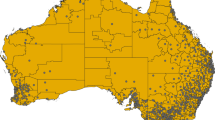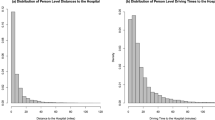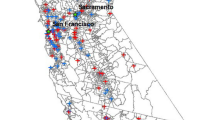Abstract
The purpose of this study is to determine whether a custom Google Maps application can optimize site selection when scheduling outpatient interventional radiology (IR) procedures within a multi-site hospital system. The Google Maps for Business Application Programming Interface (API) was used to develop an internal web application that uses real-time traffic data to determine estimated travel time (ETT; minutes) and estimated travel distance (ETD; miles) from a patient’s home to each a nearby IR facility in our hospital system. Hypothetical patient home addresses based on the 33 cities comprising our institution’s catchment area were used to determine the optimal IR site for hypothetical patients traveling from each city based on real-time traffic conditions. For 10/33 (30%) cities, there was discordance between the optimal IR site based on ETT and the optimal IR site based on ETD at non-rush hour time or rush hour time. By choosing to travel to an IR site based on ETT rather than ETD, patients from discordant cities were predicted to save an average of 7.29 min during non-rush hour (p = 0.03), and 28.80 min during rush hour (p < 0.001). Using a custom Google Maps application to schedule outpatients for IR procedures can effectively reduce patient travel time when more than one location providing IR procedures is available within the same hospital system.

Similar content being viewed by others
References
Murphy TP, Soares GM: Critical appraisal of the technical practice model for interventional radiology. Semin Interv Radiol. 22(1):17–20, 2005
Syed ST, Gerber BS, Sharp LK: Traveling towards disease: Transportation barriers to health care access. J Community Health. 38(5):976–993, 2013
Boulos MNK: Towards evidence-based, GIS-driven national spatial health information infrastructure and surveillance services in the United Kingdom. Int J Health Geogr. 3(1):1, 2004
Probst JC, Laditka SB, Wang J-Y, Johnson AO: Effects of residence and race on burden of travel for care: cross sectional analysis of the 2001 US National Household Travel Survey. BMC Health Serv Res. 7:40, 2007
Zucca A, Boyes A, Newling G, Hall A, Girgis A: Travelling all over the countryside: travel-related burden and financial difficulties reported by cancer patients in New South Wales and Victoria. Aust J Rural Health. 19(6):298–305, 2011
Schuurman N, Fiedler RS, Grzybowski SCW, Grund D: Defining rational hospital catchments for non-urban areas based on travel-time. Int J Health Geogr. 5:43, 2006
Onega T, Lee CI, Benkeser D, Alford-Teaster J, Haas JS, Tosteson ANA et al.: Travel burden to breast MRI and utilization: Are risk and sociodemographics related? J Am Coll Radiol JACR. 13(6):611–619, 2016
Liu E, Santibáñez P, Puterman ML, Weber L, Ma X, Sauré A et al.: A quantitative analysis of the relationship between radiation therapy use and travel time. Int J Radiat Oncol Biol Phys. 93(3):710–718, 2015
Bruner DW, Pugh SL, Yeager KA, Bruner J, Curran W: Cartographic mapping and travel burden to assess and develop strategies to improve minority access to national cancer clinical trials. Int J Radiat Oncol Biol Phys. 93(3):702–709, 2015
Ayyalasomayajula B, Wiebe N, Hemmelgarn BR, Bello A, Manns B, Klarenbach S et al.: A novel technique to optimize facility locations of new nephrology services for remote areas. Clin J Am Soc Nephrol CJASN. 6(9):2157–2164, 2011
Baskin L, Abdullah A, Guo M, Naugler C: Use of geospatial mapping to determine suitable locations for patient service centers for phlebotomy services. Am J Clin Pathol. 144(5):727–730, 2015
Gu W, Wang X, McGregor SE: Optimization of preventive health care facility locations. Int J Health Geogr. 9:17, 2010
Smallman-Raynor MR, Muir KR, Smith SJ: The geographical assignment of cancer units: patient accessibility as an optimal allocation problem. Public Health. 112(6):379–383, 1998
Fleischman RJ, Lundquist M, Jui J, Newgard CD, Warden C: Predicting ambulance time of arrival to the emergency department using global positioning system and Google maps. Prehospital Emerg Care Off J Natl Assoc EMS Physicians Natl Assoc State EMS Dir. 17(4):458–465, 2013
Author information
Authors and Affiliations
Ethics declarations
Conflict of Interest
The authors declare that they have no conflict of interest.
Rights and permissions
About this article
Cite this article
Mandel, J.E., Morel-Ovalle, L., Boas, F.E. et al. Optimizing Travel Time to Outpatient Interventional Radiology Procedures in a Multi-Site Hospital System Using a Google Maps Application. J Digit Imaging 31, 591–595 (2018). https://doi.org/10.1007/s10278-018-0054-2
Published:
Issue Date:
DOI: https://doi.org/10.1007/s10278-018-0054-2




